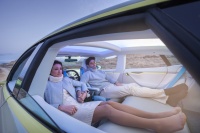Morgan Stanley Says Shared Mobility and Autonomous Cars to Drive EV Growth (TSLA)

In a notehat has positive implications for Tesla (NASDAQ: TSLA), Morgan Stanley analyst Adam Jonas said they are 'Serious EV Bulls Again.' In his report, Jonas argues that while electric vehicles (EV) have failed to achieve mainstream success given inferior economic payback, shared mobility and autonomous cars could help EVs make a major comeback.
1. Shared mobility. Mobile technology and relatively simple software increases driving utilization rates by an order of magnitude bring taxis and chauffeur services to the masses. This transforms the auto business model from B2C ownership to B2B shared. Enabling each car to drive a far greater number of miles per year helps amortize the up-front cost of a battery far more rapidly, shrinking the payback. Greater numbers of EVs enable OEMs and contract manufacturers to achieve unprecedented scale economies in battery pack production, yielding further benefits.
To take the point of vehicle utilization vs. EV payback rates to the extreme, imagine that the owner of a 50KWh battery car used the vehicle for the very rare Sunday drive of 100 miles/year… the extra premium paid for the car vs. owning a 40mpg car at $3/gallon gasoline would take 2,778 years to pay off. To break-even vs. an internal combustion engine, such a vehicle would have be purchased in the 8th Century BC, at the founding of Rome or during Homer’s epics (ignoring inflation). If the same car were used 1,000 miles/year the breakeven payoff would be 278 years, or purchased when George Washington was a 5 year old lad rambling around the fields in the Colony of Virginia. On the flipside, if the EV were operated 100,000 miles/year, the payback would be 2.8 years. To achieve the same 2.8 year payback by only shrinking the battery cost (holding miles driven flat at 10,000/year) would require $25/KWh… a 90% reduction from Tesla’s current claimed level of cost achievement. $25/KWh would require technological breakthrough, while 100k miles/year just requires a smarter use of technology that already exists.
2. Autonomous cars. Eliminating the human from the driving equation can further improve utilization to even higher levels and efficiency and lower cost per mile. By far the largest cost of today’s ride sharing service is the person behind the wheel. Replace the driver with a few million lines of code and some commoditized sensors and the savings can really begin. Shared autonomous fleets address many other problems with today’s EV model, such as slower charging time, lower charging station density and range limitations. Out of a total autonomous taxi fleet of say 10,000 vehicles, perhaps 10% or 20% would be involved in some portion of the charging process. Please note, we are not considering any material differences in maintenance/repair costs between an EV and an ICE vehicle.
Jonas also sees a potential 'Apple effect'. If Apple were to design and engineer a car, they are convinced it would be 100% a battery electric propulsion system. Apple's potential ‘sponsorship’ of the so-far beleaguered EV technology could have transformational ramifications for the industry, he said.
Read more : http://www.streetinsider.com/


/http%3A%2F%2Fpbs.twimg.com%2Fcard_img%2F1303144707619532801%2F3-iTleij%3Fformat%3Djpg%26name%3Dsmall)
/http%3A%2F%2Fwww.autonomousvehicleinternational.com%2Fwp-content%2Fuploads%2F2020%2F08%2FFord-Michigan-Science-Center-1.jpg)
/http%3A%2F%2Fcleantechnica.com%2Ffiles%2F2020%2F07%2FFaurecia-Cockpit-of-the-Future-Autonomous-Cars-Wellness.jpg)
/http%3A%2F%2Fcdn-images-1.medium.com%2Fmax%2F800%2F1%2AAr3L_tI2Ow54sCoDmcfnmg.jpeg)
